lip filler injection techniques pdf

Lip augmentation using dermal fillers has surged in popularity, driven by advancements in filler technologies and injection techniques. Hyaluronic acid fillers are minimally invasive, offering a versatile approach to enhance lip volume and shape.
Overview of Lip Augmentation
Lip augmentation is a cosmetic procedure designed to enhance the appearance of the lips, primarily by increasing their volume and definition. This is frequently achieved through the injection of dermal fillers, most commonly composed of hyaluronic acid (HA). The procedure is minimally invasive and has gained significant popularity due to its relatively quick results and minimal downtime. Augmentation can address concerns such as thin lips, asymmetry, and loss of lip volume associated with aging. Various injection techniques are employed to achieve different aesthetic outcomes, ranging from subtle enhancements to more dramatic transformations. Proper understanding of lip anatomy and filler properties is essential for safe and effective lip augmentation, ensuring natural-looking results that meet patient expectations. Furthermore, the use of personalized physiotherapy is an effective factor in relieving complications after lip contouring.
Popularity and Advancements in Dermal Fillers
The demand for lip augmentation has risen substantially in recent years, fueled by advancements in dermal filler technology and refined injection techniques. Hyaluronic acid (HA) fillers have become the gold standard due to their biocompatibility, reversibility, and ability to provide natural-looking results. Ongoing research and development have led to fillers with improved longevity, texture, and ease of injection. These advancements have expanded the possibilities for lip enhancement, allowing practitioners to achieve more precise and customized outcomes. The increasing popularity is also attributed to greater awareness and accessibility of these procedures, along with the desire for enhanced facial aesthetics. These developments in dermal fillers have minimized potential complications and maximized patient satisfaction, further contributing to their widespread use in lip augmentation procedures. Belotero easily combines with any anti-age correction, returning beauty and confidence to patients.
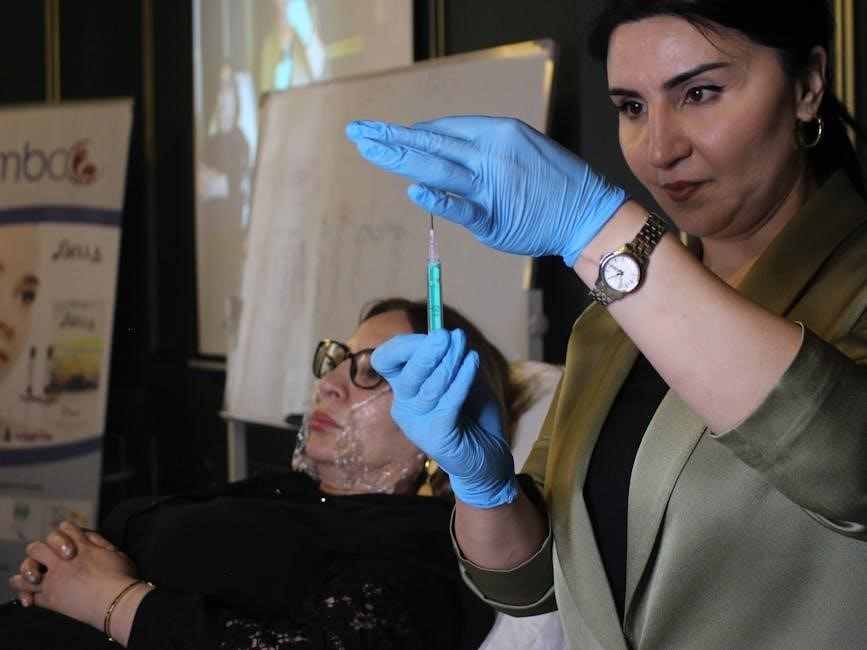
Anatomy and Physiology for Lip Fillers
A comprehensive understanding of lip anatomy is crucial for safe and effective filler injections. This knowledge guides precise placement, avoiding complications and achieving optimal aesthetic outcomes in lip augmentation procedures.
Understanding Lip Structure

Understanding the intricate structure of the lips is paramount for successful lip augmentation. The lips comprise several key components, including the vermilion border, which defines the lip outline, and Cupid’s bow, the distinct curve in the upper lip. The philtrum, the vertical groove above Cupid’s bow, also contributes to lip aesthetics. The orbicularis oris muscle, responsible for lip movement, underlies these structures.
Knowledge of these anatomical landmarks is essential for precise filler placement. Superficial injections above the orbicularis oris muscle can help avoid inadvertent injection into the labial artery. This detailed anatomical understanding ensures safe and natural-looking results, enhancing overall facial harmony and patient satisfaction. Proper technique is vital.
Vascular Anatomy of the Lips
A thorough understanding of the lip’s vascular anatomy is crucial for minimizing complications during filler injections. The superior and inferior labial arteries, branches of the facial artery, supply blood to the lips. These arteries typically run within the submucosal plane, close to the orbicularis oris muscle. Variations in arterial course are common, necessitating careful consideration during injection procedures.
Inadvertent intravascular injection can lead to serious adverse events, including vascular occlusion and tissue necrosis. Injecting superficially above the muscle may reduce the risk of hitting the artery. Precise knowledge of vascular pathways and meticulous injection techniques, such as aspiration before injection, are essential for patient safety. The lips have a complex vascular anatomy.
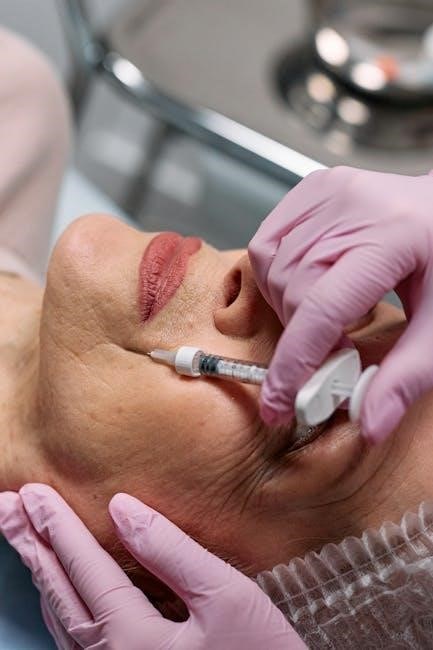
Hyaluronic Acid (HA) Dermal Fillers
Hyaluronic acid (HA) is the most frequently used dermal filler in lip augmentation due to its biocompatibility, reversibility, and ability to attract and retain water, providing natural-looking volume enhancement.
HA as the Most Common Dermal Filler
Hyaluronic acid (HA) stands as the predominant choice for dermal fillers in lip augmentation procedures, largely due to its exceptional biocompatibility and inherent reversibility. Its popularity is further cemented by its remarkable capacity to attract and retain water molecules within the injected area. This unique characteristic allows HA fillers to seamlessly integrate with the surrounding tissues, resulting in a natural-looking enhancement of lip volume and contour.
Furthermore, the versatility of HA fillers extends to their availability in varying densities and formulations, enabling practitioners to tailor treatments to individual patient needs and desired aesthetic outcomes. The ability to fine-tune the filler characteristics ensures optimal results, whether aiming for subtle enhancements or more pronounced volumization, making HA the go-to option for achieving beautiful, natural-looking lips.
Mechanism of Action of HA Fillers
Hyaluronic acid (HA) fillers work primarily by physically augmenting the lip tissue, creating immediate volume upon injection. The HA molecules attract and bind to water, expanding the injected area and providing a plumping effect. Beyond mere volume, HA interacts with the surrounding tissue, stimulating collagen production over time.
This neocollagenesis contributes to long-term improvement in lip texture and elasticity, enhancing the overall aesthetic outcome. The HA gel integrates within the extracellular matrix, providing structural support and improving hydration. Moreover, the enzyme hyaluronidase can readily dissolve HA, providing a safety net for correcting overfilled areas or undesired results. This reversibility further contributes to the appeal of HA fillers.
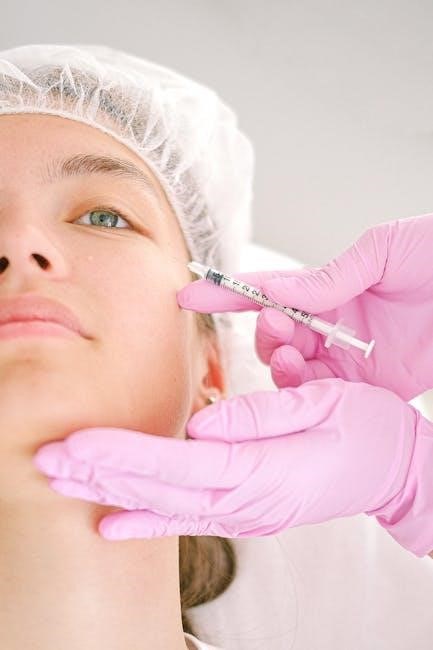
Injection Techniques
Various injection techniques exist for lip augmentation, including linear retrograde threading, vertical injections, the four-point technique, and the six-step approach. Each method offers unique advantages for desired outcomes.
Linear Retrograde Thread Technique
The linear retrograde thread technique involves injecting the dermal filler as the needle is withdrawn, creating a smooth, even thread of product within the lip. This technique focuses on precision and control, allowing the injector to deposit filler strategically along the vermillion border or within the body of the lip to achieve the desired volume and shape. A fine-gauge needle is typically used, and the entry point is made at a shallow angle, usually around 30 degrees, above the wet-dry border; Superficial injections in the vermillion are key. This method minimizes the risk of irregularities and ensures a natural-looking result by carefully layering the filler. The linear retrograde technique is versatile and can be adapted to address various lip concerns, from subtle enhancement to more significant volume augmentation, offering a reliable approach for achieving symmetrical and well-defined lips.
Vertical Injection Techniques
Vertical injection techniques involve injecting the dermal filler perpendicular to the lip border, creating small columns of product. This method is often used to add height and projection to the lips, particularly in the central portion. The needle is inserted vertically into the lip, and small boluses of filler are deposited to lift and plump the tissue. The practitioner should avoid injecting too superficially to prevent discoloration. This approach is particularly useful for creating a more defined Cupid’s bow and enhancing the overall shape of the lips. It requires careful placement and precise control to avoid over-projection or an unnatural appearance. Vertical injections can be combined with other techniques, such as linear threading, to achieve a balanced and harmonious result, addressing both volume and contour. Awareness of vascular anatomy is crucial for minimizing complications.
Four-Point Injection Technique
The four-point injection technique divides the lips into equal right and left sides, utilizing four entry points above the vermilion border. This method aims for symmetrical volume distribution and enhanced lip contour. Small aliquots of hyaluronic acid filler are injected at each point, carefully placed to augment the lip’s shape. The technique allows for precise control over the filler placement, minimizing the risk of asymmetry. Typically, two injection points are used on the upper lip and two on the lower lip. This approach provides subtle enhancement while maintaining a natural appearance. The practitioner must consider the patient’s individual anatomy and desired outcome. Careful attention to injection depth and amount ensures optimal results and reduces potential complications such as lumpiness or unevenness. This technique is favored for its simplicity and effectiveness in achieving balanced lip augmentation.
Six-Step Injection Technique
The six-step injection technique involves strategic placement of approximately twelve injections, using around 0.1 cc of hyaluronic acid per injection, distributed across the upper and lower lips. This method ensures comprehensive and balanced volume augmentation. The injections target key areas to enhance lip shape, definition, and projection. The practitioner carefully assesses the patient’s lip anatomy to determine the optimal injection sites. This technique often includes injections to accentuate the Cupid’s bow and define the vermilion border. By administering small amounts of filler at multiple points, the risk of overfilling is minimized. This approach allows for precise sculpting and contouring, creating a natural and harmonious result. The six-step technique requires a thorough understanding of lip anatomy and injection techniques. It is favored for its ability to achieve a refined and well-defined lip appearance.
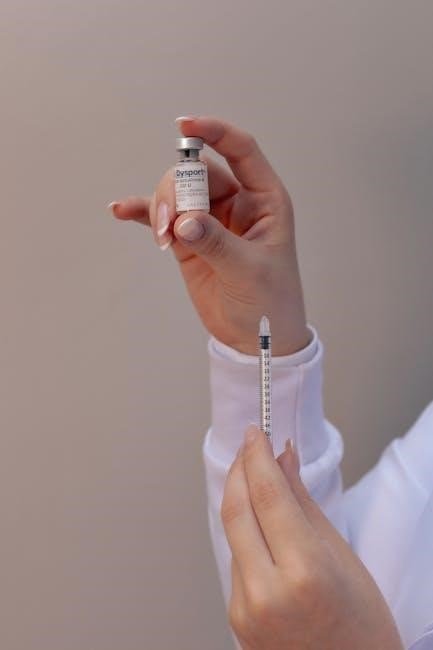
Injection Procedure Details
The lip filler injection procedure involves several key considerations, including the choice between needle and cannula techniques, precise control over injection angle and depth, and careful management of the amount of HA used.
Needle vs. Cannula Technique
The choice between using a needle or a cannula for lip filler injections depends on the aesthetic provider’s experience and comfort level. Needles allow for precise placement of the filler with direct control, making them suitable for detailed work and small areas. Cannulas, on the other hand, offer a reduced risk of vascular complications due to their blunt tip, which pushes aside vessels rather than puncturing them.
Cannulas may also minimize bruising and swelling, as they require fewer entry points. However, cannulas may provide less precision compared to needles, potentially requiring more filler to achieve the desired outcome. Ultimately, the choice hinges on the practitioner’s skill and the patient’s specific needs and anatomy.
Injection Angle and Depth
The injection angle and depth are critical factors in achieving optimal results and minimizing complications during lip filler procedures. A shallow, superficial injection, particularly with hyaluronic acid fillers, can lead to staining or discoloration, especially in individuals with thin skin. Injecting above the orbicularis oris muscle helps avoid inadvertent injection into the labial artery.
A common technique involves entering the skin at approximately a 30-degree angle for linear retrograde threading. The appropriate depth ensures the filler is placed within the correct tissue plane to provide support and volume without creating irregularities or palpable lumps. Precise control over angle and depth is essential for a natural-looking outcome.
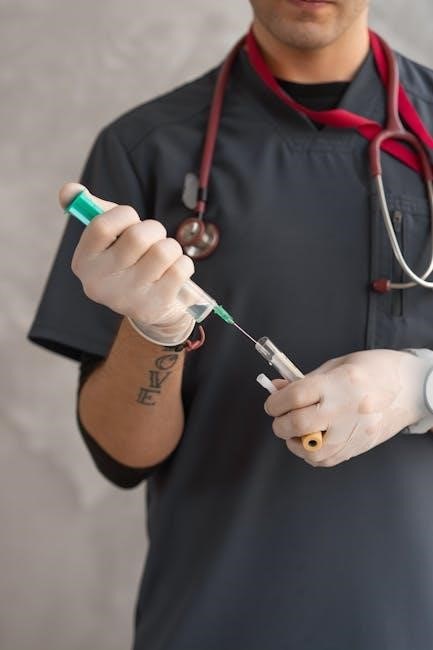
Amount of HA per Injection
The amount of hyaluronic acid (HA) dermal filler used per injection site is a crucial determinant of the final aesthetic outcome in lip augmentation. A conservative approach is often preferred, especially for first-time patients, to avoid overfilling and unnatural results. In a six-step technique, approximately 0.1 cc of HA is administered per injection, strategically placed in the upper and lower lips.
The total volume injected depends on individual lip anatomy and desired fullness. Precision is key; small, controlled amounts allow for gradual buildup and refinement. A small amount of filler accentuates the philtrum and evert the upper lip.
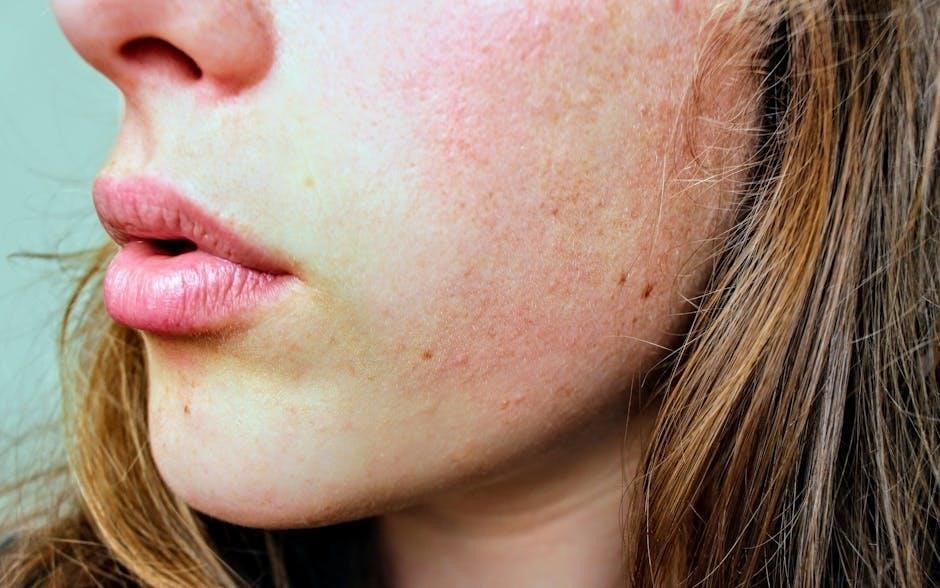
Complications and Side Effects
Staining or discoloration can occur at the injection site, especially with superficial HA filler placement in thin skin. Knowledge of anatomy helps avoid inadvertent injection into the labial artery.
Staining or Discoloration at Injection Site
Staining or discoloration at the injection site represents a potential complication following lip filler procedures, predominantly when hyaluronic acid (HA) dermal filler is injected too superficially, especially in individuals with thin skin. This phenomenon arises due to the Tyndall effect, where light scatters off the HA particles, creating a bluish or whitish hue visible through the skin.
Prevention involves precise injection depth and technique. Injectors should be mindful of the skin’s thickness and vascularity, particularly avoiding superficial placement near the vermilion border. Proper assessment and meticulous execution minimize the risk. If discoloration occurs, management options include hyaluronidase injections to dissolve the filler, although careful administration is crucial to prevent over-correction.

Maintaining impeccable hygiene is paramount during filler injections. Standard practices, mirroring any medical procedure, are crucial to minimize infection risks and ensure patient safety throughout the augmentation process;
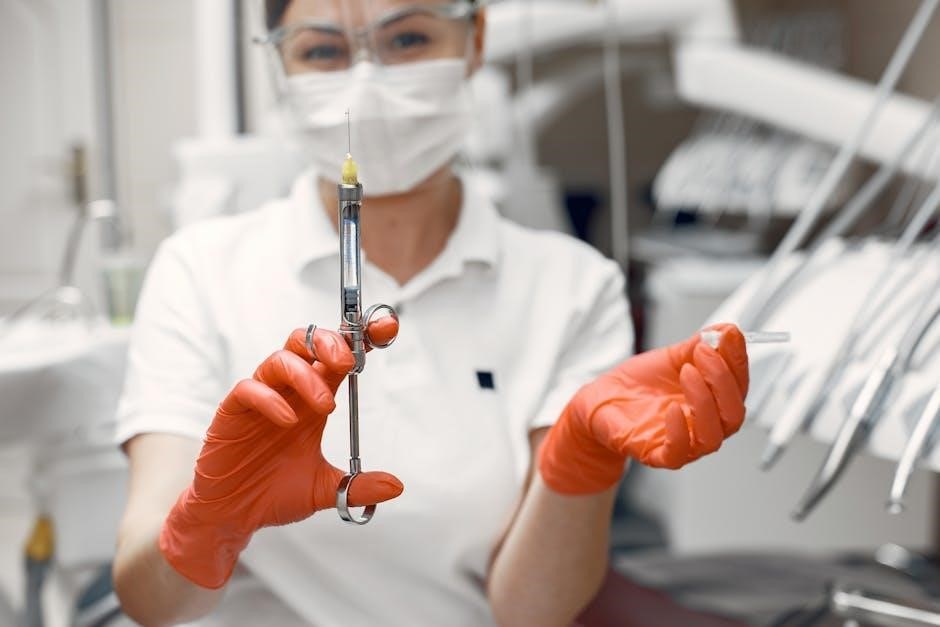
Hygiene and Safety Measures
Standard Hygiene Practices
Adhering to stringent hygiene protocols is non-negotiable during any filler injection treatment, mirroring the standards upheld in medical practices. This encompasses meticulous hand hygiene, employing antiseptic solutions for skin preparation, and maintaining a sterile field. The use of sterile gloves and single-use needles is mandatory to avert cross-contamination risks. Proper disposal of sharps in designated containers is crucial, along with adherence to universal precautions for infection control. Aseptic techniques should be consistently applied throughout the procedure, minimizing the potential for bacterial introduction. Furthermore, the treatment environment must be thoroughly cleaned and disinfected before and after each patient. These practices collectively safeguard patient well-being and mitigate adverse events.